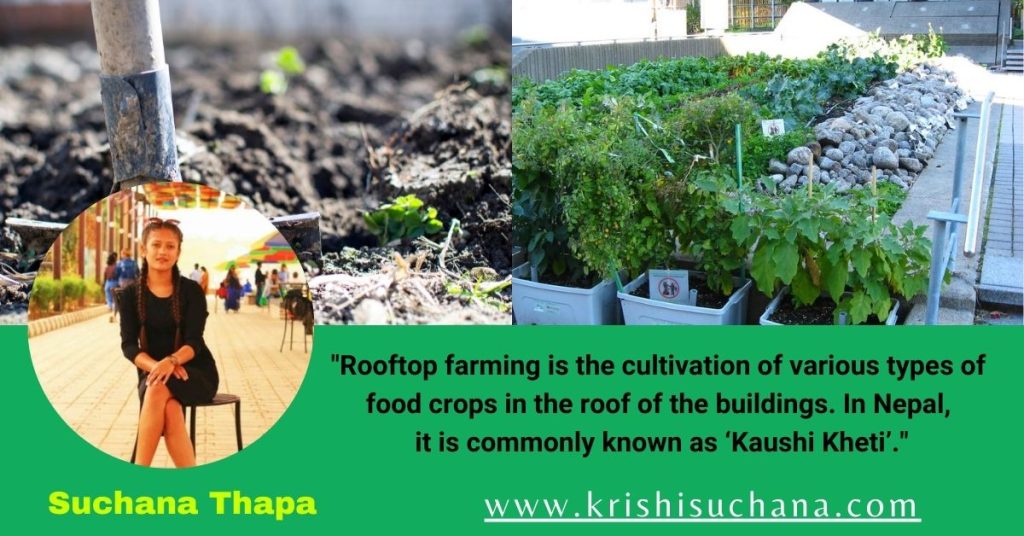ROOFTOP FARMING – INTRODUCTION, METHODS, CHALLENGES

INTRODUCTION
In the modern times of massive misuse of pesticide and degrading soil fertility, the threat of health hazards while consuming the market vegetables are inside the minds of people somewhere. Roof top gardening may seen a small step but it is a leap ahead for sustainability and combating the havoc of climate change hazards.
Rooftop farming is the cultivation of various types of food crops in the roof of the buildings. In Nepal, it is commonly known as ‘Kaushi Kheti’. This type of farming is primarily done in urban areas where there is no appropriate agricultural lands.
METHODS OF ROOF TOP FARMING:
Rooftop farming is generally done using the green roof, hydroponics, aeroponics , or container gardens. Here are some methods explaining the process of rooftop farming:
i) Required size of container must be of minimum 1ft. wide and 1.5 ft. long would be appropriate for this farming.
ii) To minimize the overflow of irrigation, a piece of brick of approximately 5cm should be kept at the bottom of the container.
iii) Irrigation should be done properly in proper time.
iv) While filling the container with soil, soil shouldn’t be filled tie upto its mouth.
v) Kitchen wastes can be utilized as compost manure for the farming.
vi) Dung manure can be the best for this rooftop farming as chemical fertilizers contain different types of gases and minerals which is hazardous to our health.In case, if dung manure isn’t available, home made compost manures can be utilized as the best alternatives.
vii) During summer season, plants become dry or even die due to excessive temperature, so the container should be shifted towards shaddy and cool places.
viii) The plants which are of tall breeds should be planted behind and the plants which are of short breeds should be planted forward. By doing so, it will be easy for us to give proper nourishment to the plants.f there are climber plants, it is better to plant them near the walls or railings.
ix) Various plants seeds can be grown in our own home by using plastic bags or trays.
In short, proper selection of container, irrigation and care of crops ,selection of soil and control of pests and diseases should be properly considered for the rooftop farming.
IMPORTANCE OF ROOFTOP FARMING
i) Rooftop farming is getting attraction mainly in the urban areas and it is easy to handle economic and enjoys the health benefits of chemical free vegetables as it doesn’t contain any hazardous insecticides.
ii)It makes the city green, the waste management, enhances the air quality and easily provides unadulterated, fresh and nutritious food products.
iii) It helps to promote local production.
iv) Rainwater can be utilized properly.
v) It helps to control noise pollution as plants absorbs carbon dioxide and convert it into oxygen.
vi) The rooftop farming helps to redce the Urban Heal Island (UHI) which means that plant can absorbs some of the sunlight and provide shade for the building.
CHALLENGES OF ROOFTOP FARMING
i) Unlike a typical farming, rooftop farming requires intricate and costly drainage system to ensure no water seeps into the building through ting cracks and crevices in the walls or drips down the side of the building.
ii) The structure and weight of roof garden can causes a problem, for overall building.
iii) The rooftop garden include the capital cost of building terraces and times required to maintain terraces.
SOLUTIONS TO CHALLENGES OF ROOFTOP FARMING
i) Use of light rooting media other than soil like coco peat, clay balls, can be practiced. Durable grow bags can be used instead of heavy clay pots.
ii) To avoid the fear/threat of Ceiling dampness/Roof dampness the container should be placed over brick or any firm substance.
iii) The problem of the excessive sun is prevalent on the roof which reduces the moisture level in the growing substrate and leads to violation of nutrients. For overcoming this problem, continuous moisture should be maintained by installing a drip irrigation system.
iv) For avoiding the problems of hailstones and strong wind prevalence in monsoon, hail nets can be used to avoid hail problem and good staking must be maintained to make plants more stable.
v) The government sectors should make people aware of the probable good impact of trainings and seminars about rooftop gardening in growers through training.
CONCLUSION
Hence, we can conclude that rooftop farming can be a potential way to meet the growing demand of fresh food and also make a major improvement in the quality life of urban people by contributing to the various environmental benefits.
Writer: Suchana Thapa (Student, Bsc. Ag IAAS Paklihawa Campus)

 एउटा यस्तो विषालु भ्यागुता, जसको मुल्य नै पर्छ ३ लाख, जान्नुहाेस्
एउटा यस्तो विषालु भ्यागुता, जसको मुल्य नै पर्छ ३ लाख, जान्नुहाेस्  भोलि र पर्सि बालबालिकालाई भिटामिन ए खुवाइदै
भोलि र पर्सि बालबालिकालाई भिटामिन ए खुवाइदै  खगराज अधिकारी गण्डकीको मुख्यमन्त्री नियुक्त
खगराज अधिकारी गण्डकीको मुख्यमन्त्री नियुक्त  सुनसरीमा दुवै पक्षबीच सहमति, कर्फ्यु खुकुलो हुदै
सुनसरीमा दुवै पक्षबीच सहमति, कर्फ्यु खुकुलो हुदै  स्टेफेनको शतकमा आयरल्याण्ड वोल्भ्सले नेपाल ए लाई दियो २८५ रनको लक्ष्य
स्टेफेनको शतकमा आयरल्याण्ड वोल्भ्सले नेपाल ए लाई दियो २८५ रनको लक्ष्य 



Well done.